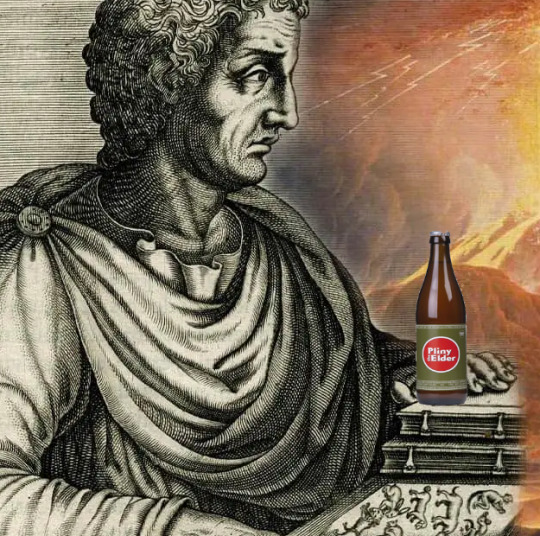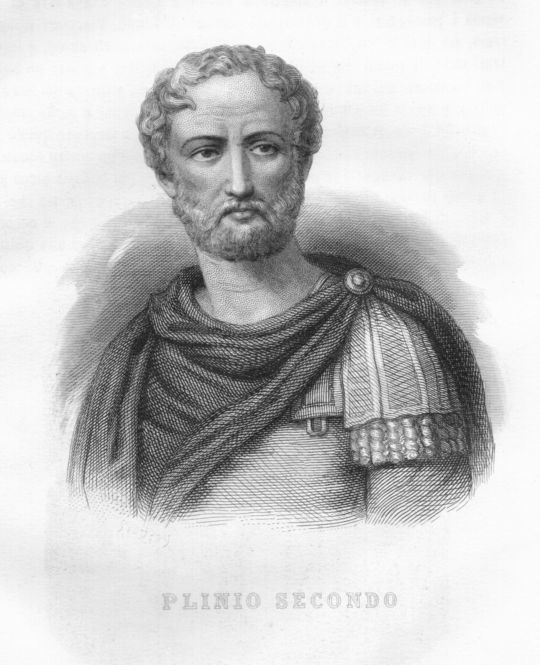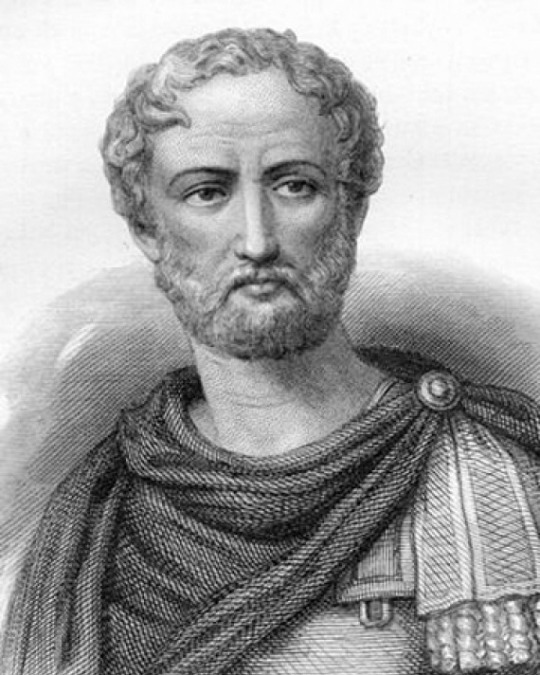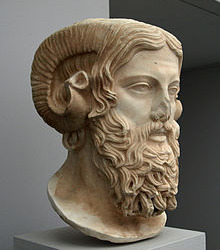#Pliny the elder
Explore tagged Tumblr posts
Text

me: brrr, it's a cold day! might grab myself a hot cocoa or a coffee!
pliny the elder: wow. literal freak behavior
#im sorry this is funny to me pliny#he will moralize about anything#pliny the elder#tagamemnon#queueusque tandem abutere catilina patientia nostra
16K notes
·
View notes
Text
As late as the fourth century CE in a satire attributed to the emperor Julian, Octavian (the later Augustus) is described as “changing many colors, like a chameleon: becoming now pale and now red”. In the satire, the god Silenus reacts to seeing Octavian by saying, “Bless me, what changeable beast is this! What terrible thing will he do to us!”
For comparison we have Pliny the Elder's comment on chameleons from his Natural History 8.120: "And [the chameleon] is more miraculous for the nature of its color, for it constantly changes its eyes and tail and entire body, and always resembles whatsoever it touches last, except red and white”
Pliny’s mention of the chameleon’s inability to turn “red and white” (rubrum candidumque) makes Julian’s description of Octavian turning pale (ὠχριῶν) and red (ἐρυθρὸς) take on a greater significance because it shows that Octavian is then more skilled than a chameleon at changing color by possessing the capability to turn both red and white.
Although Silenus' comment makes it clear that Octavian's color-changing should be seen as a reflection of his instability and danger, the change in color could also be an allusion to Octavian's constant change in health as ὠχριῶν refers to becoming pallid. Pliny further strengthens this reading by writing that when dead, chameleons are pale (defuncto pallor est). Thus Octavian is constantly changing between a state of near-death and great vitality as implied by Julian's ἐρυθρὸς and Pliny's rubrum, both of which can mean having a ruddy complexion.
#tagamemnon#Octavian#Augustus#pliny the elder#Julian the Apostate#Roman history#Latin literature#Ancient Greek
494 notes
·
View notes
Text






























history + last words
#history#mary wollstonecraft#oscar wilde#giles corey#agrippina the younger#pliny the elder#matoaka#pocahontas in other names but i just went with her actual name#jack daniel#historyedit#words#art
808 notes
·
View notes
Text
ROUND 1: PLINY THE ELDER (real) VS DWIGHT SCHRUTE (the office)


#pliny the elder#pliny#pliny ass bitch!!!#dwight#dwight the office#dwight schrute#the office#tournament#a1#now kill
916 notes
·
View notes
Text
youtube
Pliny Explains it All : The Historia Naturalis Book I-II Abridged
from Sam O'Nella Academy
38 notes
·
View notes
Text
Early in the morning of October 25, 79 (year 832 in ancient Rome), Gaius Plinius Secundus, better known as Pliny the Elder, died on the coast of Stabia during the expulsion of the last pyroclastic surge that came out of Vesuvius. The interesting thing is that he is the only writer and military of the ancient world who died due to a natural disaster . Ironically, his passion was the study of nature. Born in 23, spent his childhood and teens during the reign of Tiberius ( 14-37) whom he referred to as "the saddest of men". He praised the emperor Claudius (41-54) saying that "Claudius was one of the best writers of Rome". During the reign of Nero (54-68) Pliny attended the construction of the Domus Aurea, emperor's palace.

Pliny began his military career in Germania. During the reign of Vespasian (December 69-June 79) he was procurator in Gaul and Hispania. Pliny was a close friend of Vespasian who in 77 appointed him Roman Navy Commander, that is why Pliny settled with his family in Misenum on the coast of the Gulf of Naples. He tried to help in the disaster but ended up among the victims of one of the most known and deadly volcanic eruptions in history.

His last book, from his encyclopedia Naturalis Historia (Natural History), Pliny dedicated it to Titus Flavius, who became emperor four months before the tragedy.
Today we know what happened thanks to Pliny the Younger, also a writer, who documented in detail what he saw from Misenum as well as the testimonies he heard from the survivors in Stabia who were with his uncle.
According to Pliny the Younger, his uncle's body was recovered from the beach of Stabia at dawn the following day : "My uncle's body was found intact and just as he was dressed; he seemed asleep rather than dead."

Pliny the Elder is among the most prominent writers of the 1st century, and the only celebrity among the victims of Vesuvius.
285 notes
·
View notes
Text
Time Travel Question 15: The Library of Alexandria (Latin Edition)
If you have any non-Library of Alexandria lost works suggestions or more library of Alexandria items, please pop them in below for future polls.
#Time Travel#Emperor Claudius#Etruscan#Carchedonica#Petronius#Satyricon#Sulla#Agrippina the Younger#Livy#Pliny the Elder#Trajan#Dacians#Sulpicius Alexander
328 notes
·
View notes
Text


i love when he stands up
23 notes
·
View notes
Note
Helloo I hope you're doing well :) I was reading about Hector and realised I've never seen him outside of the Iliad. Does he appear in other texts ?
Hello and thank you very much for your sweet words and your ask! Oh yes of course. Hector appears in a plethora of ancient Greek and Roman texts but the real test is to see him outside the context of the Trojan war! Hahaha!
For example Hector appears in plenty of texts by Apollodorous in various contexts and he even mentions how Hector was the one to kill Protesilaus and that is mentioned in several sources more I believe Hyginus included as well as a writer called Philostratus mentions the death of Protesilaus by the hands of Hector. Pausanias mentions Hector in one painting or image sitting in a mourning manner next to the Ethipian king Memnon after the Thracian Thamyris. Plutarch also mentions Hector in various of his texts in the context of Trojan War. Eurypedes mentions Hector in many of his tragedies. Strabo makes mentions to Hector during his geographical expeditions. Plato mentions Hector a lot in his work (even in Apology), Pindar as well as Diodorus Siculus. Last but not least we have Aristotle who mentions Hector in various of his works.
For other roman sources we have of course the Aenead by Virgil and Ovid. Even Pliny the Elder makes mentions to Hector and of course P. Virgilius Maro as he makes commentary on Virgils' Aenead. P. Ovidius Naso also mentions him in his work among other written roman sources including Horace
For his physical description we again have the classic cases of Malalas and Dares the Phrygian. And of course again we have kinda contradictory accounts on him:
Dares the Phrygian: Hector spoke with a slight lisp. His complexion was fair, his hair curly. His eyes would blink attractively. His movements were swift. His face, with its beard, was noble. He was handsome, fierce, and high-spirited, merciful to the citizens, and deserving of love. Malalas: dark-skinned, tall, very stoutly built, strong, good nose, wooly-haired, good beard, squinting, speech defect, noble, fearsome warrior, deep-voiced.
To name a few writers who mention him! Happy to provide the passages you want in the future. Most of the contexts in which Hector is being mentioned is around the trojan war and the epic cycle or used as an example for rethorics. ^_^
And of course do not forget how Hector's name is being mentioned to Linear B tablets! ;)
I hope this helps!
#katerinaaqu answers#hector#tagamemnon#greek mythology#ancient sources#hector's name#hector of troy#heroes of the trojan war#homer#aristotle#apollodorus#pausanias#eurypedes#malalas#dares the phrygian#ovid#virgil#strabo#plato#pliny the elder#pindar#diodorus siculus
21 notes
·
View notes
Note
if you're doing paracelsus, the guy, can you do pliny the elder?


Please reblog for a larger sample size.
44 notes
·
View notes
Text

highly recommend reading pliny the elder if only for the footnotes. theyre like video game loading screen tips
15K notes
·
View notes
Text
Pliny the Elder creating his D&D character background:

102 notes
·
View notes
Text
Laughing at the weird thing Pliny does with the gendering of gemstones in NH 37.
"Pompey, how could you make your portrait in pearls: pearls are for women! [...] For example, Caligula liked to wear them".
"Amber is only ever in demand with women [...] For example, Nero decorated the gladiatorial arena and weapons with amber".
"Emeralds are a woman thing... for example, emperor Claudius..."
#pliny the elder#gender: julio-claudian#i can understand if nero played women so well that pliny believed his acting. pliny is known to believe things.
38 notes
·
View notes
Text
Throwback Thursday: Who named ammonites?
When it comes to ammonites, most folks think of the Jurassic Coast and Mary Anning.


But did you know that she was not the first to find or even name them? The first mention of ammonites was actually around 77 AD in the Naturalis Historia, the world's first encyclopedia, written by ancient Roman naturalist, Pliny the Elder.

He spent about a decade or more writing the 37 book series. It covered everything from botany,

zoology,

astronomy,

geology,

and mineralogy.

Unfortunately, he didn't get to finish (even after 37 books) due to his untimely death due to a certain volcano that blew in 79 AD.

However, he did get to name ammonites, which means "horns of Ammon" after the Egyptian God Amun, who was often depicted with rams horns.

#paleontology#trivia#fun facts#fossils#ammonite#pliny the elder#pompeii#amun#ancient rome#ancient egypt
62 notes
·
View notes
Text
stuck in an airport in NorCal… 😩

They have Pliny the Elder beer!!! 🤩
45 notes
·
View notes
Text
I thought it was really cool that medieval Christians around the year 900 were already aware that Venus and Mercury orbited the Sun, and not Earth; but I think Pliny the Elder might have been aware of this fact too???
11 notes
·
View notes